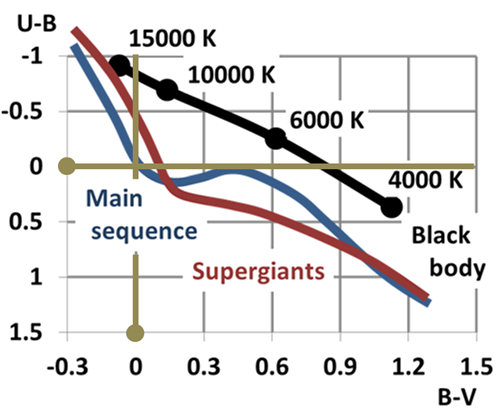What we strictly have to cover in the Syllabus
8.5.3.2.1 That is focus area 5 column 2 point 1
define the relationship between the
temperature of a body and the
dominant wavelength of the radiation
emitted from that body
On the most basic level a body is an object of more than a few hundred atoms, and the hotter it is the more blue it is.
Blackbodies are a class of bodies that were theoretically discussed in 1860 by a scientist call Kirchoff,
Simply put anylight falling on them get absorbed so that any light coming from them has been generated by the body. Now for the next 40 years scientist fooled around making blackbody radiators, then taking spectra. Finally they got black body spectra and Planck modeled it and this lead to Modern Physics, but that is another story
1900 was close enough to make do calculations. 2009 we are getting close but we are still not there, light goes in and never comes out, only the heat light comming from the body. So far "blackbody" only really turns up next year in the HSC Astrophysics Option.
So the modern defintion of a Blackbody radiator is
A blackbody allows all incident radiation to pass into it (no reflected energy) and internally absorbs all the incident radiation (no energy transmitted through the body). This is true of radiation for all wavelengths and for all angles of incidence. Hence the blackbody is a perfect absorber for all incident radiation
Siegel, Robert; Howell, John R. (2002). Thermal Radiation Heat Transfer; Volume 1 (4th ed.). Taylor & Francis. p. 7. ISBN 1-56032-839-8. http://books.google.com/books?id=O389yQ0-fecC&pg=PA7.
So here is my summary from the point of view of a spectroscophist, baring in mind
Most things coffee cups and stars, are good black body radiators in the visible, perfect in the infrared, and to varying degrees poor in the UV. So if you use the black body Weins law that looks at the peak wavelength, you get a good temperature, if you use an infrared bolometer that looks at the curve in the IR you get a great reading, and UV you get a more or less view of the structure of what you are looking at. That is how different it is from a little Pt box with carbon nano tubes in it.
This is a plot of how badly stars deviate from the BBR curve (black) in the UV which people dont use to determine temperature, because the curve is not valid there. Basically the is not a fix surface for a surface temperture. Stars get hotter in the inside, and so there is no defined temperature. Supergiants have colder outer layers to the UV escape surface is higher. The curves above represent UV deficit
More in depth is given in this web text http://cseligman.com/text/sun/blackbody.htm
This is from, http://homepages.wmich.edu/~korista/sun-images/solar_specbb.jpg as you can see
1. IR good
2. Peak fair
3. UV lousy
I would interpret this as the UV light powering, more visible light from the sun but this is an observation not a published piece of science.
Friday 23 March 2012
Sunday 12 February 2012
How to understand Electrons
1. Metals are regular 3D array of positive nuclei (example Mg++ nuclei)
2. Electrons(example e- and e- from the Mg++) swim around the nuclei
2. Electrons(example e- and e- from the Mg++) swim around the nuclei
2.1 Here is a realistic picture of electrons swimming around a metal, They are not "classical electrons" but actually give bulk to the metal (dont worry until you do Quantum Mechanics at UNI)
3. Electrons are like trout in a tank, the walls are like the WORK FUNCTION
4. There are three ways to get electrons out of a metal
4.1 Fire an ion from a low pressure gas (throw a rock in the trout pond and trout will jump out)
4.2 Heat up the metal called THERMIONIC EMISSION (Heat it up Elmo?)
4.3 Hit out the electrons with UV light PHOTOELECTRIC effect (Laser)
Subscribe to:
Posts (Atom)




